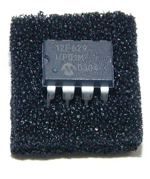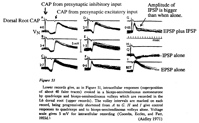“The One-Minute” (March 1, addendum)
This afternoon at the Media Lab, we had the poster session for the Masters students graduating this year. The lower atrium of the Lab is set up with big foamcore panels, and everyone comes down, puts up their poster, and hovers nearby. I went by about halfway through to see what people are up to with their work these days. While wandering around, I passed Director Frank Moss several times — he was perusing the posters and chatting up the hoverers, of course. And when he walked up to Nick, he said, “Alright, gimme your one-minute.”
<deep breath> Man, what would I say in one minute about my work?
Giving a “one-minute” is one of those things that we learn hard here at the Lab. And it’s something I definitely need some good hard practice at.
Conductive foam

I always just thought that the foam that my DIPs came on was to protect all the little pins coming out of the chip. Today in my sensors class, JoeP told us that the foam these chips come on is actually conductive foam, which protects the chips from static electricity.
Nerd fact. And an old way to display data.
- MIT has an a capella group called the Chorallaries. That is just about the nerdiest thing I’ve ever heard. Except for the Integration Bee.
- In HST.723 today, our teacher was telling us about an experiment “they did back in the 50s”, when people didn’t have easy ways of getting the data off of oscilloscopes. (They were measuring action potentials in neurons.) So, instead of tabulating data and creating graphs showing just the average, variance, etc. (like they would today), they just showed the 20 scope traces, all on top of each other, on the same axes. This struck me as a really straightforward, elegant (even though it may now be generally considered crude), way to show all of the data, while letting the user summarize it themselves.

Visualizing Music
This is the place to post comments to Visualizing Music, a project I have been working on for the past month or two.


How a comparator really works
Finally, I see how a comparator really works. Like, how to bias the negative input to get a simple threshold, and how to add one resistor in a positive feedback loop to get the behavior of a Schmitt trigger with hysteresis. Awesome.
The first thing
Choosing something to start with is an intimidating task. I think I’m going to make an allowance that I do not have to choose just one thing each day; rather, I can choose as many as I want. Hooray for more things worth learning!
That said, here is the thing I choose as “the best thing i learned today”:
I’m reading Brian C. J. Moore’s An Introduction to the Psychology of Hearing. In the section entitled “Basic Structure and Function of the Auditory System” (specifically, pp. 22-23 in the 5th edition), Moore discusses the functions of the middle ear (aka those little bones you learned about in elementary school – the hammer, the anvil, and the stirrup). The first function is to transmit sound effectively from the air in the ear canal to the fluid in the cochlea just past your eardrum (it’s an impedance-matcher), which is a really beautiful thing, if you look closely at it.
But the second function, he says, is to “reduce the transmission of bone-conducted sound to the cochlea.” If you’re chewing, the bones in your skull would naturally vibrate, including the bones in your middle ear. These little ear bones would transmit the waves to the cochlea, so these noises would “appear loud and have the effect of masking external sounds.” Bad news. However, the guy who studied all of this, Bárány, showed that the sounds are only transmitted to the cochlea “when there is differential movement between the ossicles and the skull.” Our middle ear is positioned exactly so that it minimizes this possible differential movement. So we can still hear when we’re eating! And, perhaps even more interesting, Moore suggests that birds and reptiles, who have a more simple middle ear that does transmit skull vibrations to the cochlea, “swallow their food whole rather than chewing it, whereas mammals chew their food.”
Wow. I mean, seriously. Is it for real? Only the speculation of science knows!
Close competitors:
- Arrive on time for talks by Edward Tufte, if you really want to see him.
- T stops now appear on Google maps
- A search for “blood blisters” is the second-most common referrer to my website, behind “anita lillie”, so far this month.